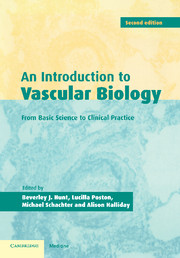Book contents
- Frontmatter
- Contents
- List of contributors
- Preface
- Part I Basic science
- 1 Vascular tone
- 2 Vascular compliance
- 3 Flow-mediated responses in the circulation
- 4 Neurohumoral regulation of vascular tone
- 5 Angiogenesis: basic concepts and the application of gene therapy
- 6 The regulation of vascular smooth muscle cell apoptosis
- 7 Wound healing: laboratory investigation and modulating agents
- Part II Pathophysiology: mechanisms and imaging
- Part III Clinical practice
- Index
5 - Angiogenesis: basic concepts and the application of gene therapy
Published online by Cambridge University Press: 07 September 2009
- Frontmatter
- Contents
- List of contributors
- Preface
- Part I Basic science
- 1 Vascular tone
- 2 Vascular compliance
- 3 Flow-mediated responses in the circulation
- 4 Neurohumoral regulation of vascular tone
- 5 Angiogenesis: basic concepts and the application of gene therapy
- 6 The regulation of vascular smooth muscle cell apoptosis
- 7 Wound healing: laboratory investigation and modulating agents
- Part II Pathophysiology: mechanisms and imaging
- Part III Clinical practice
- Index
Summary
Introduction
The establishment and maintenance of a vascular supply are necessary for the growth and survival of normal and neoplastic tissues. An important distinction must be made between two types of new vessel formation: vasculogenesis and angiogenesis. The first, vasculogenesis, is the process by which primitive mesenchymal cells differentiate in situ to become the endothelial lining of embryological blood vessels. The second, angiogenesis, describes the endothelial budding and outgrowth into avascular tissue from preexisting capillaries. Vasculogenesis occurs early in embryogenesis and is completed well before independent living is established. Angiogenesis is both a physiological and pathological process that governs the majority of new vessel growth both during embryo development and throughout life.
The term ‘angiogenesis’ was first used in the 1930s to describe the formation of new blood vessels in the placenta. It has subsequently become clear that angiogenesis is a vital part of all organ growth, both in isolation, as occurs in the uterus during the menstrual cycle, and also as occurs in the normal development of an infant. In pathological states angiogenesis can be beneficial, as in wound healing and inflammation, but also detrimental, as in neoplasia, retinopathies and rheumatoid arthritis, amongst others.
Growth of new capillaries and vessels occurs in conjunction with surrounding mesenchymal tissue and is determined by mechanical, humoral and growth factors. The use of laboratory and clinical methods is rapidly expanding our understanding of the physiology and pathology of angiogenesis.
- Type
- Chapter
- Information
- An Introduction to Vascular BiologyFrom Basic Science to Clinical Practice, pp. 93 - 113Publisher: Cambridge University PressPrint publication year: 2002
- 1
- Cited by



